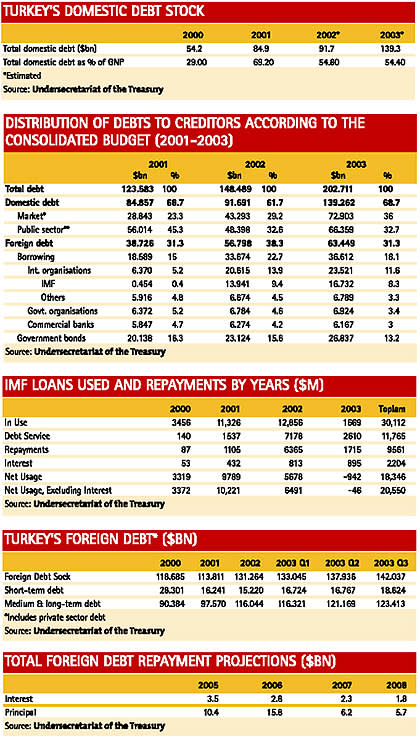External factors, the worsening of the public debt situation and an unhealthy financial system dominated by state banks, triggered several crises in Turkey’s economy during the 1990s. The net public debt stock, which accounted for only 29% of the GNP in 1990, rose to 61% of the GNP at the end of 1999. The domestic debt, which increased only 6% in 1990 jumped 41% in 1999.
The rapid rise in public debt in the latter half of the 1990s led real interest rates to soar. To diminish the risks of debt default, expand investors’ base and reduce “risk” premiums on interest rates, the government introduced a market making mechanism that continues today with 10 banks.
The fundamental principles adopted in 2002 toward public finance and debt management were sustainability, transparency and accountability and to roll over the debt in the short and medium term at the lowest cost.
Domestic issues
In 2003, Turkey’s domestic borrowing stood at $110.8bn, according to the Undersecretariat of the Treasury. Revenues from $4.8bn in special government bonds went to pay up debts to depositors of Imar Bank, under a receivership fund operated by the Central Bank. Revenues of $561m from the sale of special government bonds went to cover duty losses of state banks.
In 2003, Turkey paid $113.5bn to service its domestic debt, of which $76.1bn went to pay the principal and $37.4bn went to cover interest.
Debt maturities were extended after uncertainties caused by last year’s Iraq War began dissipating in April 2003. The extension of maturities led to the Treasury to issue two-year government bonds starting in September. Average maturities on government bonds increased to 11.5 months in 2003 from nine months in 2002.
Interest rates
Borrowing costs also dropped considerably in 2003 from 2002. Interest rates TL discounted bonds fell 25-30 percentage points beginning in June. In October, interest rates on government bonds fell to under 30%. The cost of foreign-currency-denominated domestic borrowing (in US dollars and in euros) also declined from an average 8.6% in 2002 to 5.1% in 2003. .
The percentage of government debt paper held by the banking sector also declined from 55.3% in 2002 to 51% at the end of 2003, while the percentage of private-sector securities (bonds and equities) held rose. Government debt paper held by non-banking financial companies remained unchanged in 2003 from 2002.
The public sector borrowed $9.6bn externally in 2003.
In 2003, Turkey borrowed $5.3bn in international money markets through bond issues, of which 27% was denominated in euros and 73% in US dollars. Average maturities rose to 8.6 years for euro-based bonds and 6.6 years for dollar-based bonds in 2003.
While using $1.7bn in funds from the IMF, it paid $2.6bn in 2003, including $1.7bn in principle and $895m in interest.

Up and up
What stands out is that is that both Turkey’s domestic and foreign debts are climbing and that short-term debts in total debts are also rising. In the coming years, Turkey will have to pay its debts to the IMF and a large part of these will have to be paid off in 2004, 2005 and 2006. Under the agreement with the IMF, Turkey has the choice to repay either $20.3bn or $23.7bn over the next three years.
In 2003, Turkey obtained $2.1bn project loans from the World Bank and and used $2.6bn, including credits from previous years. Some 56.2% of the loans were for transport projects, while 12.3% were for the energy sector.
The country also received $1.2bn in project finance from other official sources and $1.5bn from private creditors, including banks.
Ratings boost
The Japanese credit rating agency JCR on September 2, 2003 raised the credit outlook for Turkey from stable to positive, while maintaining a “B+” rating. Fitch raised its long-term foreign currency and lira credit ratings for Turkey, to “B” from “B-” on September 25, 2003, and to “B+” and readjusted its country outlook to stable. Standard and Poor’s (S&P) on October 16, 2003, raised its long-term foreign currency and lira denominated debt rating from “B” to “B+”. On October 21, 2003, Moody’s raised the TL-based long term debt of Turkey to “positive” and its long foreign currency debt to “stable” from “negative.”
Turkey’s government (consolidated budget) domestic debt at the end of 2003 reached $139.3bn. Turkey’s foreign debt stood at $63.5bn at the end of 2003. Turkey’s foreign debt in 2003 rose $6.6bn, including $4.8bn as a result of currency fluctuations. Some $26.8bn of the foreign debt was from bond issues, while $36.6bn was the result of loans. The largest part of the outstanding foreign debt – $16.7bn – is owed to the IMF.
The government’s domestic debt payments in 2004 will be at least $97bn. From 2005 to 2008, the government will have to service an estimated $48.5bn in foreign debt. Some 79% of these debts will be payments in principal while 21% will be in interest. Of the foreign debt servicing, $29bn stem from loans received while $19.5bn is the result of bond issues.

Restructuring banking
The law governing the Central Bank of Turkey enacted in 2001 made the bank autonomous, accountable, and increased its credibility. The Central Bank stopped providing short term advances to the Treasury and banned state institutions from borrowing.
In 2000, the Banking Supervision and Regulation Agency (BDDK) was established as an independent agency to regulate and restructure the banking sector. The Central Bank’s Savings Deposits Insurance Fund (TMSF), which works closely with the BDDK, has taken over 23 financially ailing banks since 1997. Restructuring of the banking sector has cost Turkey a total $47.2bn in taxpayers’ money. Today only Bay¦nd¦rbank and Pamukbank, which is on the verge of being merged with state-owned Halkbank, are under the protective mantle of the TMSF. The other banks have either been shut down, merged or privatised.











